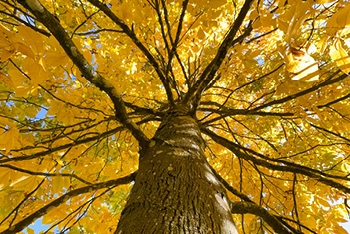Tree of the month: Shagbark hickory
The shagbark hickory- Carya ovata.
Here at Westonbirt, the golden autumn foliage of the shagbark hickory is one of our most reliable October spectacles. From the middle of the month, look out for the upright, oval crown of this large eastern North American native, as it transforms from green to a remarkable luminous yellow.
Our oldest specimens can be easily identified by their distinctive grey, fissured bark, which peels away from the tree in shaggy strips which inspire the common name of the species. This distinctive bark is typically less scaly on younger trees. A member of the walnut family, the hickories makes up part of our National Collection of Juglandaceae, which are also represented by the walnuts and the wingnuts.


Where can it be found?
Mature specimens can be found along Main Drive in the Old Arboretum and Willesley Drive in Silk Wood. Numerous young specimens collected on a Westonbirt-led expedition in 2014 can be found throughout the collection, with many examples establishing well, having been planted after only a year on the nursery. Most hickories are renowned for their significant tap root development, which makes them difficult to transplant except when very young. The team collected seed from various parts of the species’ range, from trees in Missouri, North Carolina, Tennessee, and Illinois.
Westonbirt is home to 12 species of hickory, all of which display great autumn colour.
Find the shagbark hickory tree on Westonbirt's Arboretum Explorer map...
